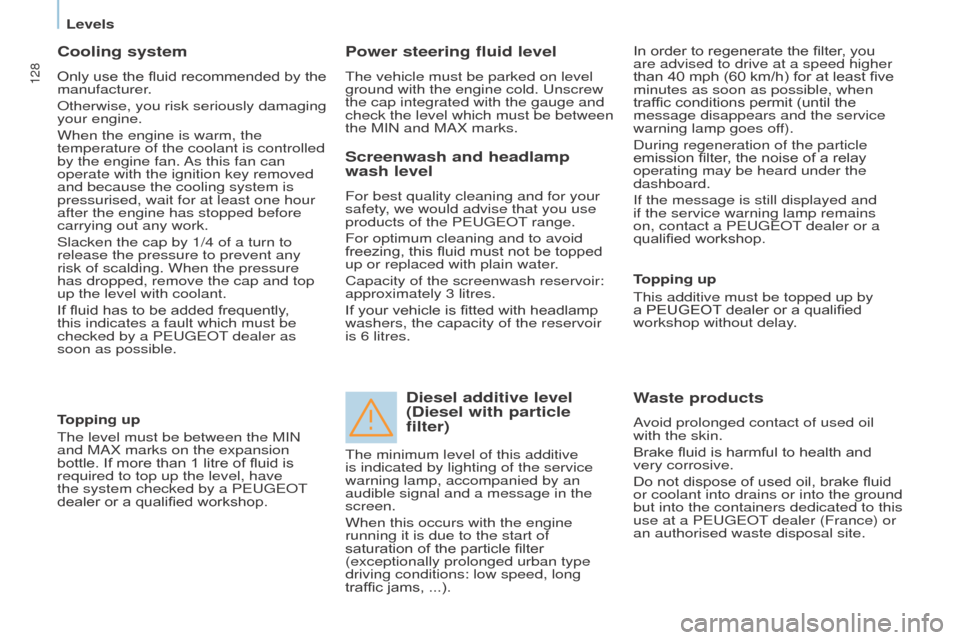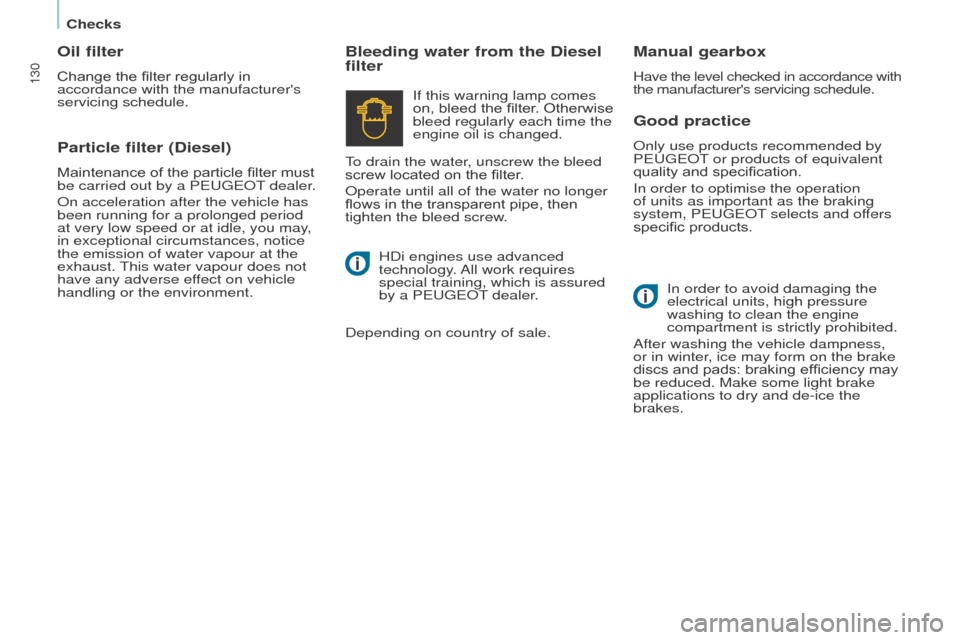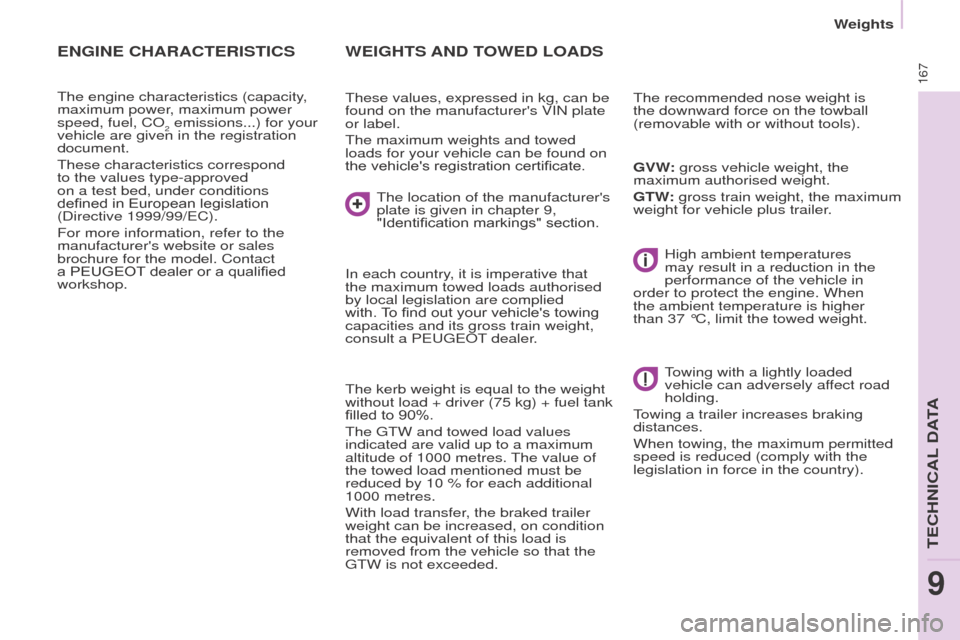2015 Peugeot Partner brake light
[x] Cancel search: brake lightPage 96 of 292

ABS
ABS
94
Partner-2-VU_en_Chap05_Securite_ed01-2015
ANTI-LOCK BRAKING SYSTEM
(ABS / EBFD)
The ABS and EBFD (electronic brake
force distribution) systems improve the
stability and manoeuvrability of your
vehicle on braking, in particular on
poor or slippery surfaces.
The ABS prevents locking of the
wheels, the EBFD provides control of
the braking pressure wheel by wheel. If this warning lamp comes
on, accompanied by an
audible signal and a message
in the screen, it indicates a
malfunction of the ABS which
could result in a loss of control of the
vehicle on braking.
If this warning lamp comes
on, together with the brake
and STOP warning lamps,
accompanied by an audible
signal and a message in the
screen, it indicates a malfunction of
the electronic brake force distribution
which could result in a loss of control of
the vehicle on braking.
EMERGENCY BRAKING
ASSIST
ANCE (EBA)
In an emergency, this system enables
the optimum braking pressure to be
reached more quickly, press the pedal
firmly without releasing it.
It is triggered by the speed at which the
brake pedal is activated.
This alters the resistance of the brake
pedal under your foot.
To prolong the operation of the
emergency braking assistance system:
keep your foot on the brake pedal.
Good practice
The anti-lock braking system comes
into operation automatically when
there is a risk of wheel lock. It does not
reduce the braking distance.
On very slippery surfaces (ice, oil,
etc...) the ABS may increase the
braking distance. When braking in
an emergency, do not hesitate to
press the brake pedal firmly, without
releasing the pressure, even on a
slippery surface, you will then be able
to continue to manoeuvre the vehicle
to avoid an obstacle.
Normal operation of the ABS may be
felt by slight vibration of the brake
pedal.
When changing wheels (tyres
and rims), ensure that these are
recommended by PEUGEOT. Stop as soon as it is safe to do so.
In both cases, contact a PEUGEOT
dealer or a qualified workshop.
Driving safely
Page 130 of 292

128
Partner-2-VU_en_Chap07_Verification_ed01-2015
Cooling system
Only use the fluid recommended by the
manufacturer.
Otherwise, you risk seriously damaging
your engine.
When the engine is warm, the
temperature of the coolant is controlled
by the engine fan. As this fan can
operate with the ignition key removed
and because the cooling system is
pressurised, wait for at least one hour
after the engine has stopped before
carrying out any work.
Slacken the cap by 1/4 of a turn to
release the pressure to prevent any
risk of scalding. When the pressure
has dropped, remove the cap and top
up the level with coolant.
If fluid has to be added frequently,
this indicates a fault which must be
checked by a PEUGEOT dealer as
soon as possible.
Power steering fluid level
The vehicle must be parked on level
ground with the engine cold. Unscrew
the cap integrated with the gauge and
check the level which must be between
the MIN and MAX marks.In order to regenerate the filter, you
are advised to drive at a speed higher
than 40 mph (60 km/h) for at least five
minutes as soon as possible, when
traffic conditions permit (until the
message disappears and the service
warning lamp goes off).
During regeneration of the particle
emission filter, the noise of a relay
operating may be heard under the
dashboard.
If the message is still displayed and
if the service warning lamp remains
on, contact a PEUGEOT dealer or a
qualified workshop.
Topping up
The level must be between the MIN
and MAX marks on the expansion
bottle. If more than 1 litre of fluid is
required to top up the level, have
the system checked by a PEUGEOT
dealer or a qualified workshop.
Screenwash and headlamp
wash level
For best quality cleaning and for your
safety, we would advise that you use
products of the PEUGEOT range.
For optimum cleaning and to avoid
freezing, this fluid must not be topped
up or replaced with plain water.
Capacity of the screenwash reservoir:
approximately 3 litres.
If your vehicle is fitted with headlamp
washers, the capacity of the reservoir
is 6 litres.
Diesel additive level
(Diesel with particle
filter)
Topping up
This additive must be topped up by
a PEUGEOT dealer or a qualified
workshop without delay.
Waste products
Avoid prolonged contact of used oil
with the skin.
Brake fluid is harmful to health and
very corrosive.
Do not dispose of used oil, brake fluid
or coolant into drains or into the ground
but into the containers dedicated to this
use at a PEUGEOT dealer (France) or
an authorised waste disposal site.
The minimum level of this additive
is indicated by lighting of the service
warning lamp, accompanied by an
audible signal and a message in the
screen.
When this occurs with the engine
running it is due to the start of
saturation of the particle filter
(exceptionally prolonged urban type
driving conditions: low speed, long
traffic jams, ...).
Levels
Page 132 of 292

130
Partner-2-VU_en_Chap07_Verification_ed01-2015
Good practice
Only use products recommended by
PEUGEOT or products of equivalent
quality and specification.
In order to optimise the operation
of units as important as the braking
system, PEUGEOT selects and offers
specific products.
Bleeding water from the Diesel
filterManual gearbox
Have the level checked in accordance with
the manufacturer's servicing schedule.
In order to avoid damaging the
electrical units, high pressure
washing to clean the engine
compartment is strictly prohibited.
After washing the vehicle dampness,
or in winter, ice may form on the brake
discs and pads: braking efficiency may
be reduced. Make some light brake
applications to dry and de-ice the
brakes.
If this warning lamp comes
on, bleed the filter. Otherwise
bleed regularly each time the
engine oil is changed.
To drain the water, unscrew the bleed
screw located on the filter.
Operate until all of the water no longer
flows in the transparent pipe, then
tighten the bleed screw.
Particle filter (Diesel)
Maintenance of the particle filter must
be carried out by a PEUGEOT dealer.
On acceleration after the vehicle has
been running for a prolonged period
at very low speed or at idle, you may,
in exceptional circumstances, notice
the emission of water vapour at the
exhaust. This water vapour does not
have any adverse effect on vehicle
handling or the environment.
Oil filter
Change the filter regularly in
accordance with the manufacturer's
servicing schedule.
HDi engines use advanced
technology
. All work requires
special training, which is assured
by a PEUGEOT dealer.
Depending on country of sale.
Checks
Page 144 of 292

142
Partner-2-VU_en_Chap08_Aide-rapide_ed01-2015
1. Parking the vehicle
- The occupants must get out of the
vehicle and wait in a safe location.
-
If possible, park the vehicle on
level, stable and non-slippery
ground.
-
Apply the parking brake, switch
of
f the ignition and engage first or
reverse gear. -
Place the chock against the wheel
diagonally opposite the one to be
changed.
CHANGING A WHEEL
2. T
ools
The tools are stowed in an open
storage compartment under a front
seat.
-
If necessary
, move the seat to
access the storage compartment
from the rear.
-
T
ake out the jack and tool carrier.
-
Remove the tools needed from the
carrier
.
1.
Jack.
2.
Wheelbrace.
3.
Chock.
4.
Rear lamp spanner
.
5.
Allow wheel trim removal tool*.
6.
T
owing eye.
If the vehicle is fitted with a towbar,
it is sometimes necessary to raise
the vehicle slightly to make it easier
to remove the spare wheel from its
carrier.
On certain types of ground and/
or if considerable loads are being
transported, call a PEUGEOT dealer or
a qualified workshop.
*
This tool is not needed for your
version.
The jack and the tool kit are specific to
your vehicle. Do not use them for other
purposes.
Changing a wheel
Page 154 of 292

152
Partner-2-VU_en_Chap08_Aide-rapide_ed01-2015
This procedure requires the use of
the spanner supplied with the tools for
changing a wheel.-
Move aside the 4 tabs then extract
the bulb holder
.
-
Remove the faulty bulb by
pressing it lightly while turning it
anticlockwise.
-
Change the bulb.
When removing the lamp unit:
-
with tailgate, pull the lamp unit
towards the centre of the vehicle,
-
with hinged doors, pull the lamp
unit towards you.When refitting, take care to
reposition the tabs and the supply
wire correctly to avoid trapping the
wire.
After changing the rear direction
indicator bulb, the reinitialisation time is
above 2 minutes.
Rear lamps
For more information concerning the
bulbs, refer to the "Types of bulb".
1.
Brake lamps / sidelamps
T
ype B, P21/5W - 21/5W
2.
Direction indicators
T
ype B, PY21W - 21W (amber)
3.
Reversing lamps
T
ype B, P21W - 21W
4.
Foglamps
T
ype B, P21W - 21W
High pressure jet washing When using this type of washing
on stubborn dirt, do not persist on
the headlamps, the other lamps
and their edges to avoid damaging
their coating and seals. Chapter 9, "Changing a wheel"
section.
Chapter 3, "Access" section.
-
Identify the faulty bulb, then open
the rear doors to 180°.
-
Remove the two fixing bolts using
the spanner provided.
-
Pull the lamp unit from the outside.
-
Holding the lamp, disconnect the
electrical connector
.
Changing a bulb
Page 169 of 292

167
Partner-2-VU_en_Chap09_Caract-technique_ed01-2015
WEIGHTS AND TOWED LOADS
These values, expressed in kg, can be
found on the manufacturer's VIN plate
or label.
The maximum weights and towed
loads for your vehicle can be found on
the vehicle's registration certificate. The recommended nose weight is
the downward force on the towball
(removable with or without tools).
In each country, it is imperative that
the maximum towed loads authorised
by local legislation are complied
with. To find out your vehicle's towing
capacities and its gross train weight,
consult a PEUGEOT dealer.
The kerb weight is equal to the weight
without load + driver (75 kg) + fuel tank
filled to 90%.
The GTW and towed load values
indicated are valid up to a maximum
altitude of 1000 metres. The value of
the towed load mentioned must be
reduced by 10 % for each additional
1000 metres.
With load transfer, the braked trailer
weight can be increased, on condition
that the equivalent of this load is
removed from the vehicle so that the
GTW is not exceeded. High ambient temperatures
may result in a reduction in the
performance of the vehicle in
order to protect the engine. When
the ambient temperature is higher
than 37 °C, limit the towed weight.
The location of the manufacturer's
plate is given in chapter 9,
"Identification markings" section.
ENGINE CHARACTERISTICS
The engine characteristics (capacity,
maximum power, maximum power
speed, fuel, CO
2 emissions...) for your
vehicle are given in the registration
document.
These characteristics correspond
to the values type-approved
on a test bed, under conditions
defined in European legislation
(Directive
1999/99/EC).
For more information, refer to the
manufacturer's website or sales
brochure for the model. Contact
a PEUGEOT dealer or a qualified
workshop. GVW: gross vehicle weight, the
maximum authorised weight.
GTW: gross train weight, the maximum
weight for vehicle plus trailer.
Towing with a lightly loaded
vehicle can adversely affect road
holding.
Towing a trailer increases braking
distances.
When towing, the maximum permitted
speed is reduced (comply with the
legislation in force in the country).
Weights
TECHNICAL DATA
9
Page 282 of 292

24
In the event of an accident or impact
under the vehicle or to one of the
charging fl aps
In the event of an accident or an
impact to the underbody of the vehicle
(for example: contact with a milestone,
a raised kerb or other urban roadside
fi xture) or in the event of an impact,
even slight, to one of the charging
fl aps, these circumstances may
have serious repercussions for your
vehicle's electrical system or traction
battery and cause damage to them.
Have your vehicle checked as soon as
possible by a franchised dealer or a
qualifi ed workshop.
Never touch the "300 Volt" components
of the orange cables exposed and
visible inside or outside of the vehicle.
In the case of serious damage to the
traction battery:
- do not try to do anything to the
vehicle yourself,
- never touch liquids coming from
the traction battery and in the event
of contact between your body and
these products, wash abundantly
with water and contact a doctor as
soon as possible.
For washing the bodywork, do
not use a pressure greater than
80 bar.
In the event of exposure to a fi re
In the event of exposure to a fi re,
leave and have everybody leave the
vehicle immediately. Never intervene
yourself (risk of electrocution). You
must contact the emergency services
immediately. Warn them that your
vehicle is electric.
Audible environment
Outside
The driver should be particularly
vigilant when driving the electric
vehicle, as it makes very little noise
when moving.
Inside
While it is operating you may hear
noises that are specifi c to an electric
vehicle, such as:
- the traction battery relays when
starting,
- the vacuum pump when braking,
- tyre or wind noise from the vehicle
when driving.
When parking on a slope, it is
recommended that you apply the
parking brake before placing the drive
selector at P
. When moving off, o
knock may be felt, which is normal.
Washing precautions
Never wash the vehicle while the
battery is on charge.
Before washing the vehicle, check
that the access fl aps are closed and
the cover on each charging socket is
closed.
In order to avoid damaging the electric
units, the use of a high pressure jet
wash is strictly forbidden:
- under the bonnet,
- under the vehicle, around the
battery packs.
Long term
When your vehicle is to be laid up
for an indeterminate period, carry out
a complete recharge of the traction
battery every three months (following
the normal charging procedure). Before
carrying out the charging operation,
ensure that the 12 V ancillaries battery
is not disconnected or discharged. If
this is the case, refer to the "Ancillaries
battery" section for information on
connecting or charging it.
Laying up the vehicle
Precautions to take when
charging the battery
- Do not stay inside or near the
vehicle.
Particularly if you wear a pacemaker
or other medial electric device.
For complete information on the
precautions to take, contact your
doctor.
- Never do any work under the
bonnet as there is a risk of serious
injury.
Risk of cuts as the fan may start
turning at any time. Risk of burns
as some areas remain very hot for
even an hour after the end of the the
charging operation.
Page 287 of 292

29
SUPPLEMENT FOR ELECTRIC MODE
SERVICING
In addition to the maintenance and warranty guide, at one year or 12 500 miles (20 000 km), whichever comes fi rst, you
must have the service listed below carried out.
Following this initial service, subsequent services must be carried out every 2 years or 25 000 miles (40 000 km)
(whichever comes fi rst).
Electric vehicle
Initial service
only carried out on the vehicle
at 1 year or 12 500 miles (20 000 km).
Routine services
every 2 years or 25 000 miles
(40 000 km) (whichever comes fi rst).
Main systematic
operations
Checks in the vehicle (horn, parking brake, ...)
Check the use-by date of the temporary puncture repair kit
Checks under the vehicle, including:
- safety checks (braking, steering, ...)
- environmental checks (sealing of circuits, gear reduction unit, ...)
Checks around the vehicle (condition of tyres, lighting and signalling, ...)
Checks under the bonnet, including topping-up fl uids if necessary (screenwash, brakes, ...)
Checks required by national legislation (other than annual technical test)
Diagnosis on electronic control units
Check the traction battery
Update the service indicator
Operations
Additional operations
Replace the coolant at 10 years
Replace the brake fl uid Every 2 years
Replace the cabin fi lter Every 2 years or 25 000 miles (40 000 km)
It is essential to observe these servicing intervals. Failure to observe the servicing intervals may have an adverse effect on
the operation of your vehicle.